BUSE 608: Market Entry Strategies for International Business in China
VerifiedAdded on 2023/05/27
|7
|1363
|396
Report
AI Summary
This report examines the use of joint ventures as a market entry strategy for international businesses in the Chinese automobile industry. It discusses the characteristics of joint ventures, motivations for foreign companies, and relevant international business theories like Dunning's theory and the international product life cycle. The report also contrasts joint ventures with exporting and licensing, highlighting their advantages and disadvantages. Key strategic players in the Chinese market, such as BMW, Nissan, Toyota, and Honda, are identified. The analysis emphasizes leveraging the Chinese platform for global expansion and revenue generation. Desklib provides access to similar solved assignments and past papers for students.
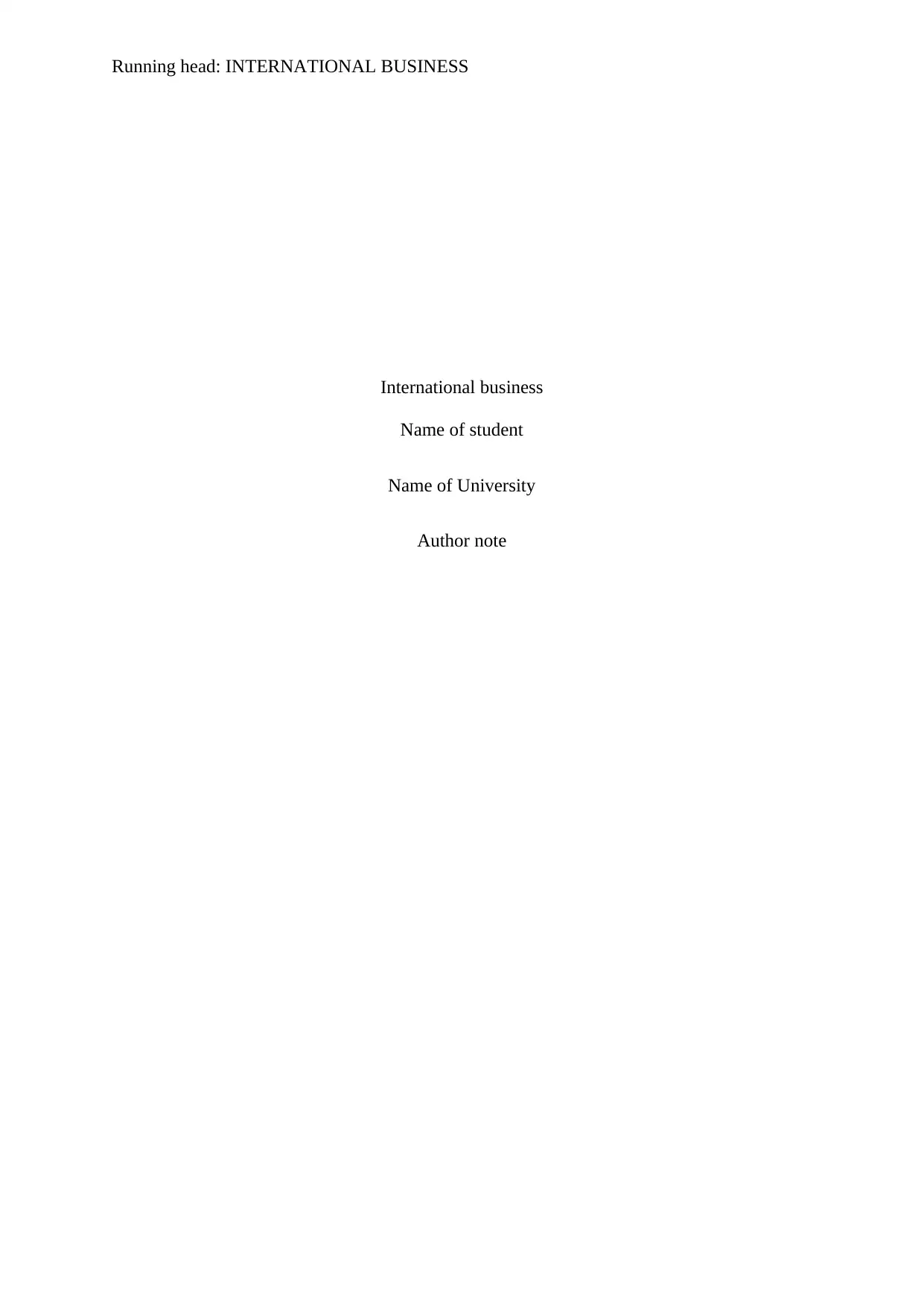
Running head: INTERNATIONAL BUSINESS
International business
Name of student
Name of University
Author note
International business
Name of student
Name of University
Author note
Paraphrase This Document
Need a fresh take? Get an instant paraphrase of this document with our AI Paraphraser
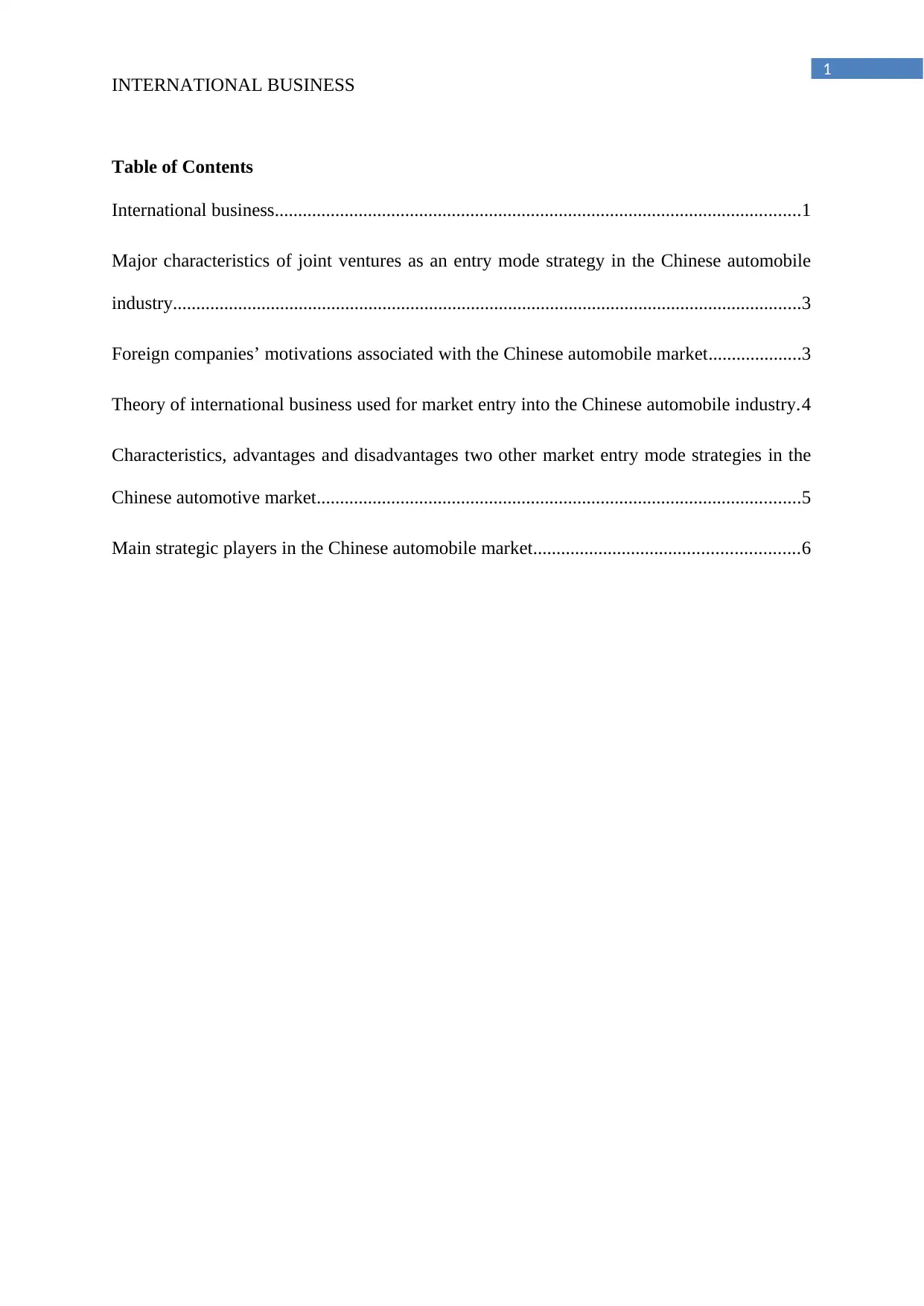
1
INTERNATIONAL BUSINESS
Table of Contents
International business.................................................................................................................1
Major characteristics of joint ventures as an entry mode strategy in the Chinese automobile
industry.......................................................................................................................................3
Foreign companies’ motivations associated with the Chinese automobile market....................3
Theory of international business used for market entry into the Chinese automobile industry.4
Characteristics, advantages and disadvantages two other market entry mode strategies in the
Chinese automotive market........................................................................................................5
Main strategic players in the Chinese automobile market.........................................................6
INTERNATIONAL BUSINESS
Table of Contents
International business.................................................................................................................1
Major characteristics of joint ventures as an entry mode strategy in the Chinese automobile
industry.......................................................................................................................................3
Foreign companies’ motivations associated with the Chinese automobile market....................3
Theory of international business used for market entry into the Chinese automobile industry.4
Characteristics, advantages and disadvantages two other market entry mode strategies in the
Chinese automotive market........................................................................................................5
Main strategic players in the Chinese automobile market.........................................................6
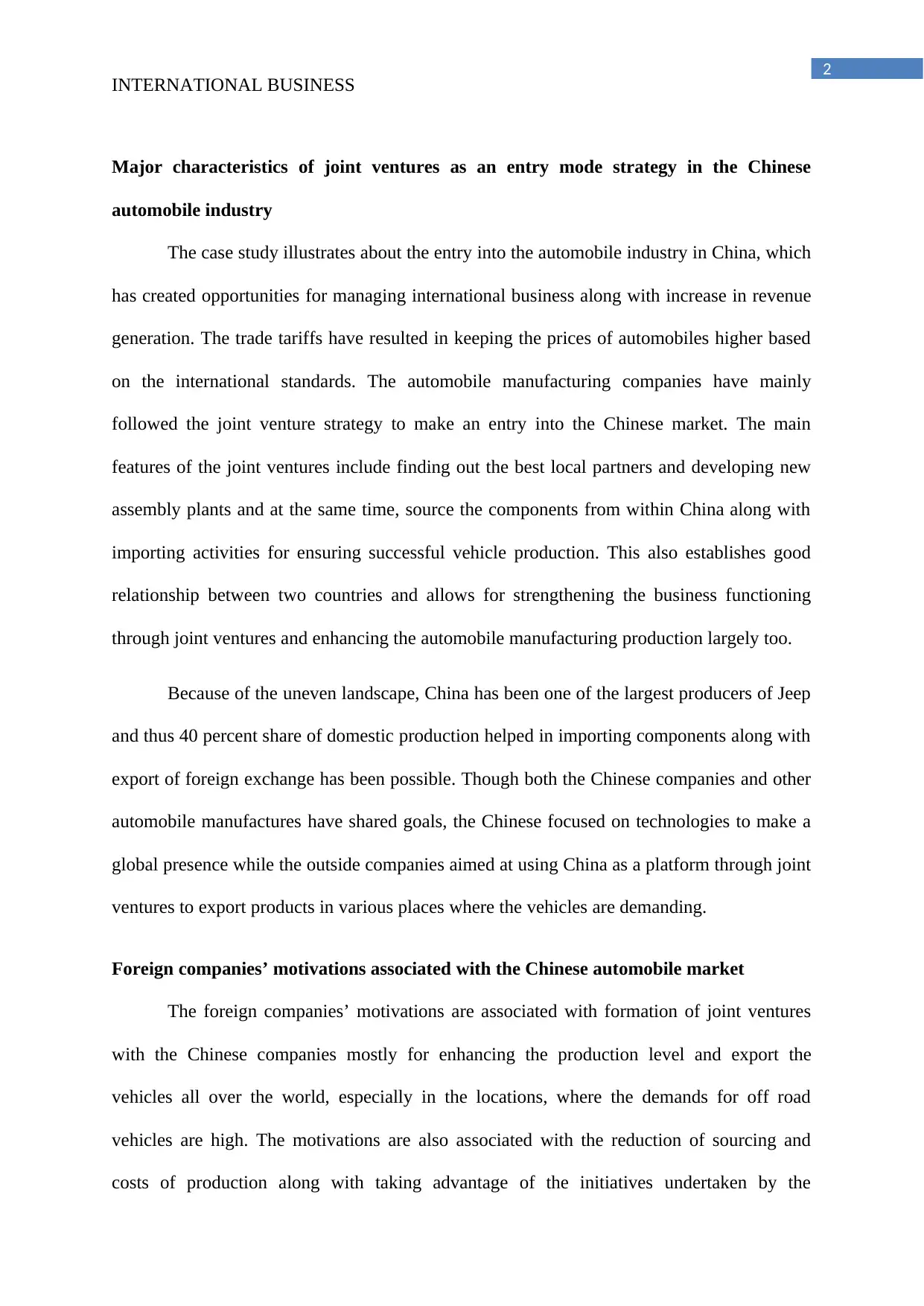
2
INTERNATIONAL BUSINESS
Major characteristics of joint ventures as an entry mode strategy in the Chinese
automobile industry
The case study illustrates about the entry into the automobile industry in China, which
has created opportunities for managing international business along with increase in revenue
generation. The trade tariffs have resulted in keeping the prices of automobiles higher based
on the international standards. The automobile manufacturing companies have mainly
followed the joint venture strategy to make an entry into the Chinese market. The main
features of the joint ventures include finding out the best local partners and developing new
assembly plants and at the same time, source the components from within China along with
importing activities for ensuring successful vehicle production. This also establishes good
relationship between two countries and allows for strengthening the business functioning
through joint ventures and enhancing the automobile manufacturing production largely too.
Because of the uneven landscape, China has been one of the largest producers of Jeep
and thus 40 percent share of domestic production helped in importing components along with
export of foreign exchange has been possible. Though both the Chinese companies and other
automobile manufactures have shared goals, the Chinese focused on technologies to make a
global presence while the outside companies aimed at using China as a platform through joint
ventures to export products in various places where the vehicles are demanding.
Foreign companies’ motivations associated with the Chinese automobile market
The foreign companies’ motivations are associated with formation of joint ventures
with the Chinese companies mostly for enhancing the production level and export the
vehicles all over the world, especially in the locations, where the demands for off road
vehicles are high. The motivations are also associated with the reduction of sourcing and
costs of production along with taking advantage of the initiatives undertaken by the
INTERNATIONAL BUSINESS
Major characteristics of joint ventures as an entry mode strategy in the Chinese
automobile industry
The case study illustrates about the entry into the automobile industry in China, which
has created opportunities for managing international business along with increase in revenue
generation. The trade tariffs have resulted in keeping the prices of automobiles higher based
on the international standards. The automobile manufacturing companies have mainly
followed the joint venture strategy to make an entry into the Chinese market. The main
features of the joint ventures include finding out the best local partners and developing new
assembly plants and at the same time, source the components from within China along with
importing activities for ensuring successful vehicle production. This also establishes good
relationship between two countries and allows for strengthening the business functioning
through joint ventures and enhancing the automobile manufacturing production largely too.
Because of the uneven landscape, China has been one of the largest producers of Jeep
and thus 40 percent share of domestic production helped in importing components along with
export of foreign exchange has been possible. Though both the Chinese companies and other
automobile manufactures have shared goals, the Chinese focused on technologies to make a
global presence while the outside companies aimed at using China as a platform through joint
ventures to export products in various places where the vehicles are demanding.
Foreign companies’ motivations associated with the Chinese automobile market
The foreign companies’ motivations are associated with formation of joint ventures
with the Chinese companies mostly for enhancing the production level and export the
vehicles all over the world, especially in the locations, where the demands for off road
vehicles are high. The motivations are also associated with the reduction of sourcing and
costs of production along with taking advantage of the initiatives undertaken by the
⊘ This is a preview!⊘
Do you want full access?
Subscribe today to unlock all pages.

Trusted by 1+ million students worldwide
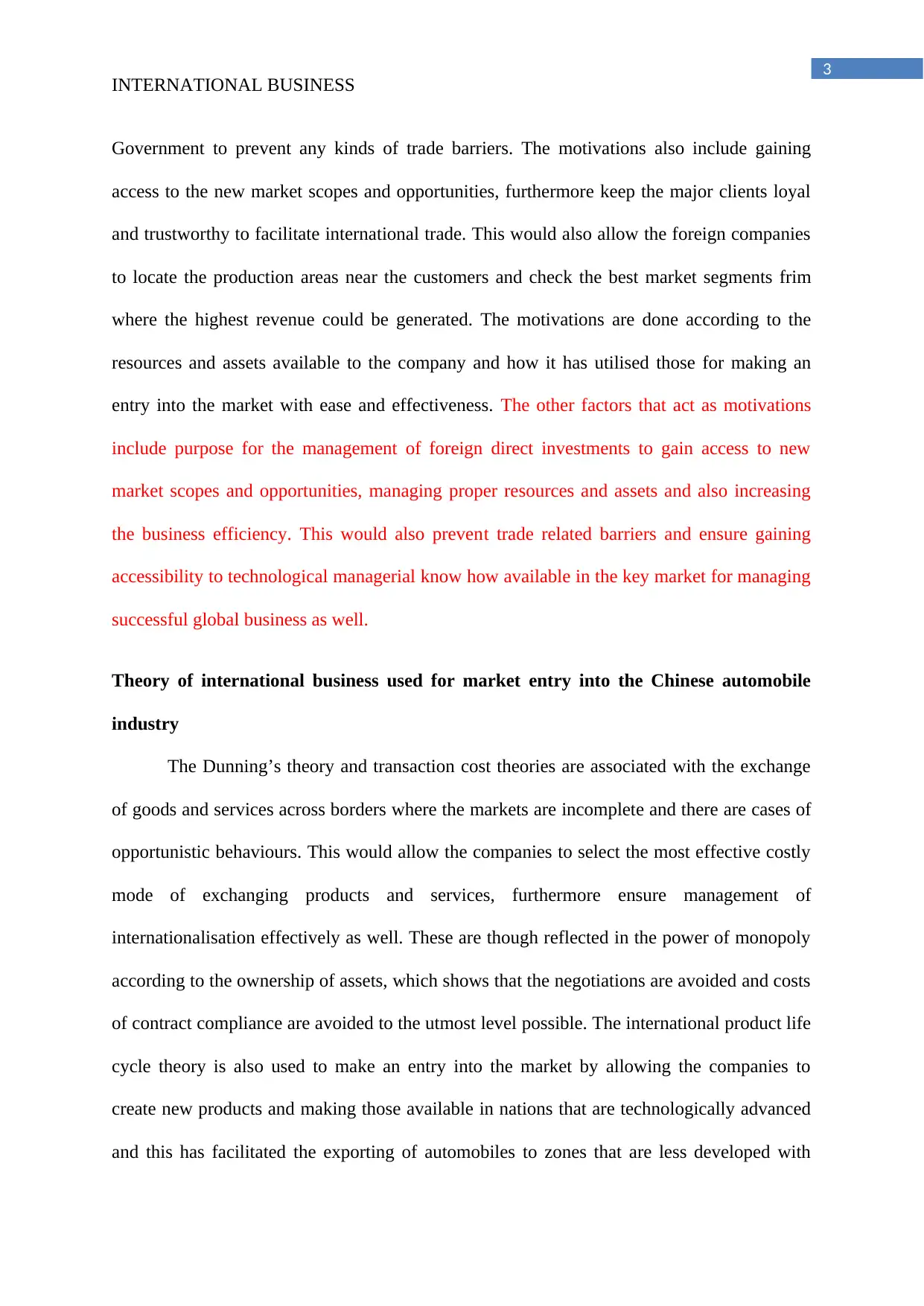
3
INTERNATIONAL BUSINESS
Government to prevent any kinds of trade barriers. The motivations also include gaining
access to the new market scopes and opportunities, furthermore keep the major clients loyal
and trustworthy to facilitate international trade. This would also allow the foreign companies
to locate the production areas near the customers and check the best market segments frim
where the highest revenue could be generated. The motivations are done according to the
resources and assets available to the company and how it has utilised those for making an
entry into the market with ease and effectiveness. The other factors that act as motivations
include purpose for the management of foreign direct investments to gain access to new
market scopes and opportunities, managing proper resources and assets and also increasing
the business efficiency. This would also prevent trade related barriers and ensure gaining
accessibility to technological managerial know how available in the key market for managing
successful global business as well.
Theory of international business used for market entry into the Chinese automobile
industry
The Dunning’s theory and transaction cost theories are associated with the exchange
of goods and services across borders where the markets are incomplete and there are cases of
opportunistic behaviours. This would allow the companies to select the most effective costly
mode of exchanging products and services, furthermore ensure management of
internationalisation effectively as well. These are though reflected in the power of monopoly
according to the ownership of assets, which shows that the negotiations are avoided and costs
of contract compliance are avoided to the utmost level possible. The international product life
cycle theory is also used to make an entry into the market by allowing the companies to
create new products and making those available in nations that are technologically advanced
and this has facilitated the exporting of automobiles to zones that are less developed with
INTERNATIONAL BUSINESS
Government to prevent any kinds of trade barriers. The motivations also include gaining
access to the new market scopes and opportunities, furthermore keep the major clients loyal
and trustworthy to facilitate international trade. This would also allow the foreign companies
to locate the production areas near the customers and check the best market segments frim
where the highest revenue could be generated. The motivations are done according to the
resources and assets available to the company and how it has utilised those for making an
entry into the market with ease and effectiveness. The other factors that act as motivations
include purpose for the management of foreign direct investments to gain access to new
market scopes and opportunities, managing proper resources and assets and also increasing
the business efficiency. This would also prevent trade related barriers and ensure gaining
accessibility to technological managerial know how available in the key market for managing
successful global business as well.
Theory of international business used for market entry into the Chinese automobile
industry
The Dunning’s theory and transaction cost theories are associated with the exchange
of goods and services across borders where the markets are incomplete and there are cases of
opportunistic behaviours. This would allow the companies to select the most effective costly
mode of exchanging products and services, furthermore ensure management of
internationalisation effectively as well. These are though reflected in the power of monopoly
according to the ownership of assets, which shows that the negotiations are avoided and costs
of contract compliance are avoided to the utmost level possible. The international product life
cycle theory is also used to make an entry into the market by allowing the companies to
create new products and making those available in nations that are technologically advanced
and this has facilitated the exporting of automobiles to zones that are less developed with
Paraphrase This Document
Need a fresh take? Get an instant paraphrase of this document with our AI Paraphraser
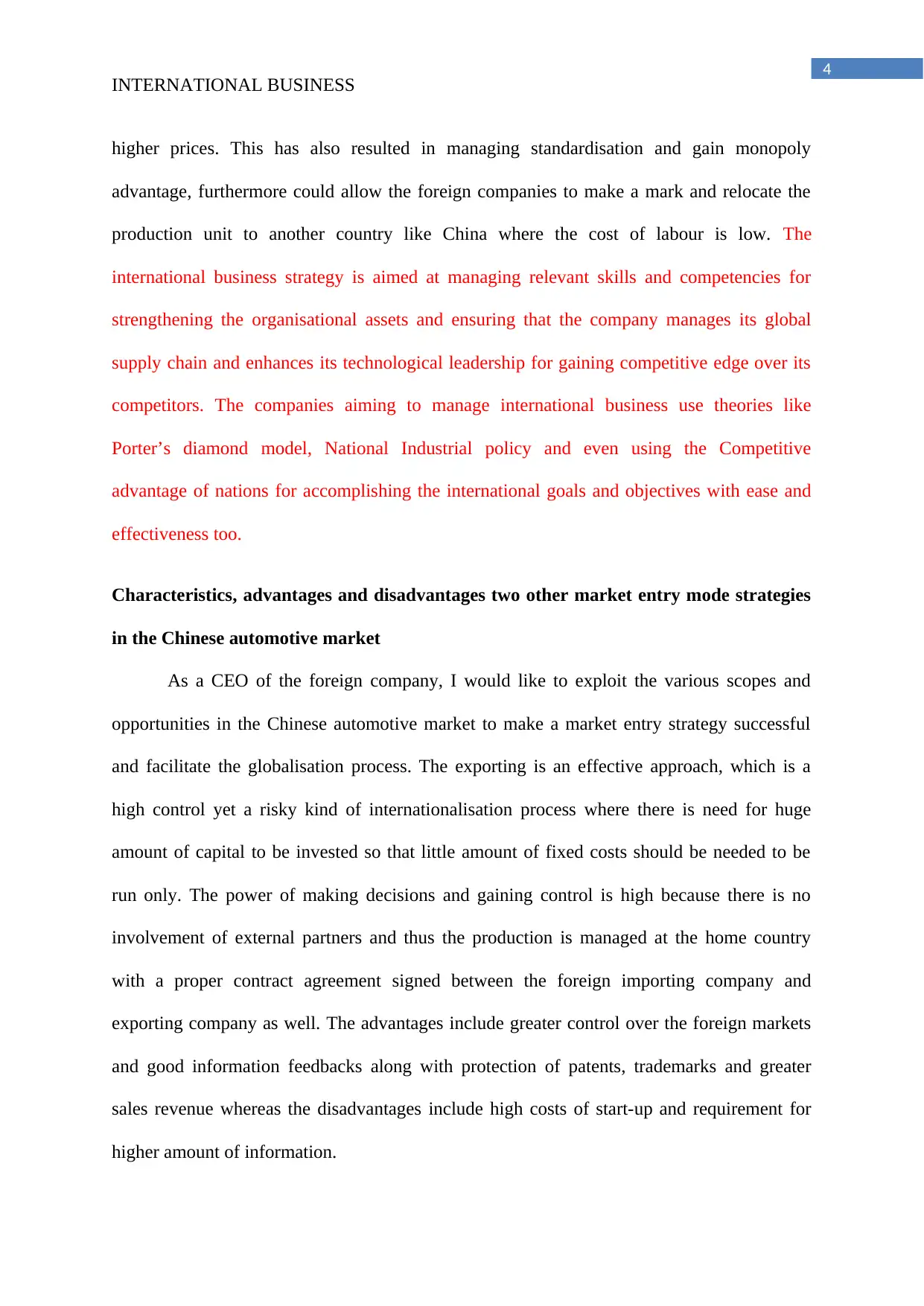
4
INTERNATIONAL BUSINESS
higher prices. This has also resulted in managing standardisation and gain monopoly
advantage, furthermore could allow the foreign companies to make a mark and relocate the
production unit to another country like China where the cost of labour is low. The
international business strategy is aimed at managing relevant skills and competencies for
strengthening the organisational assets and ensuring that the company manages its global
supply chain and enhances its technological leadership for gaining competitive edge over its
competitors. The companies aiming to manage international business use theories like
Porter’s diamond model, National Industrial policy and even using the Competitive
advantage of nations for accomplishing the international goals and objectives with ease and
effectiveness too.
Characteristics, advantages and disadvantages two other market entry mode strategies
in the Chinese automotive market
As a CEO of the foreign company, I would like to exploit the various scopes and
opportunities in the Chinese automotive market to make a market entry strategy successful
and facilitate the globalisation process. The exporting is an effective approach, which is a
high control yet a risky kind of internationalisation process where there is need for huge
amount of capital to be invested so that little amount of fixed costs should be needed to be
run only. The power of making decisions and gaining control is high because there is no
involvement of external partners and thus the production is managed at the home country
with a proper contract agreement signed between the foreign importing company and
exporting company as well. The advantages include greater control over the foreign markets
and good information feedbacks along with protection of patents, trademarks and greater
sales revenue whereas the disadvantages include high costs of start-up and requirement for
higher amount of information.
INTERNATIONAL BUSINESS
higher prices. This has also resulted in managing standardisation and gain monopoly
advantage, furthermore could allow the foreign companies to make a mark and relocate the
production unit to another country like China where the cost of labour is low. The
international business strategy is aimed at managing relevant skills and competencies for
strengthening the organisational assets and ensuring that the company manages its global
supply chain and enhances its technological leadership for gaining competitive edge over its
competitors. The companies aiming to manage international business use theories like
Porter’s diamond model, National Industrial policy and even using the Competitive
advantage of nations for accomplishing the international goals and objectives with ease and
effectiveness too.
Characteristics, advantages and disadvantages two other market entry mode strategies
in the Chinese automotive market
As a CEO of the foreign company, I would like to exploit the various scopes and
opportunities in the Chinese automotive market to make a market entry strategy successful
and facilitate the globalisation process. The exporting is an effective approach, which is a
high control yet a risky kind of internationalisation process where there is need for huge
amount of capital to be invested so that little amount of fixed costs should be needed to be
run only. The power of making decisions and gaining control is high because there is no
involvement of external partners and thus the production is managed at the home country
with a proper contract agreement signed between the foreign importing company and
exporting company as well. The advantages include greater control over the foreign markets
and good information feedbacks along with protection of patents, trademarks and greater
sales revenue whereas the disadvantages include high costs of start-up and requirement for
higher amount of information.
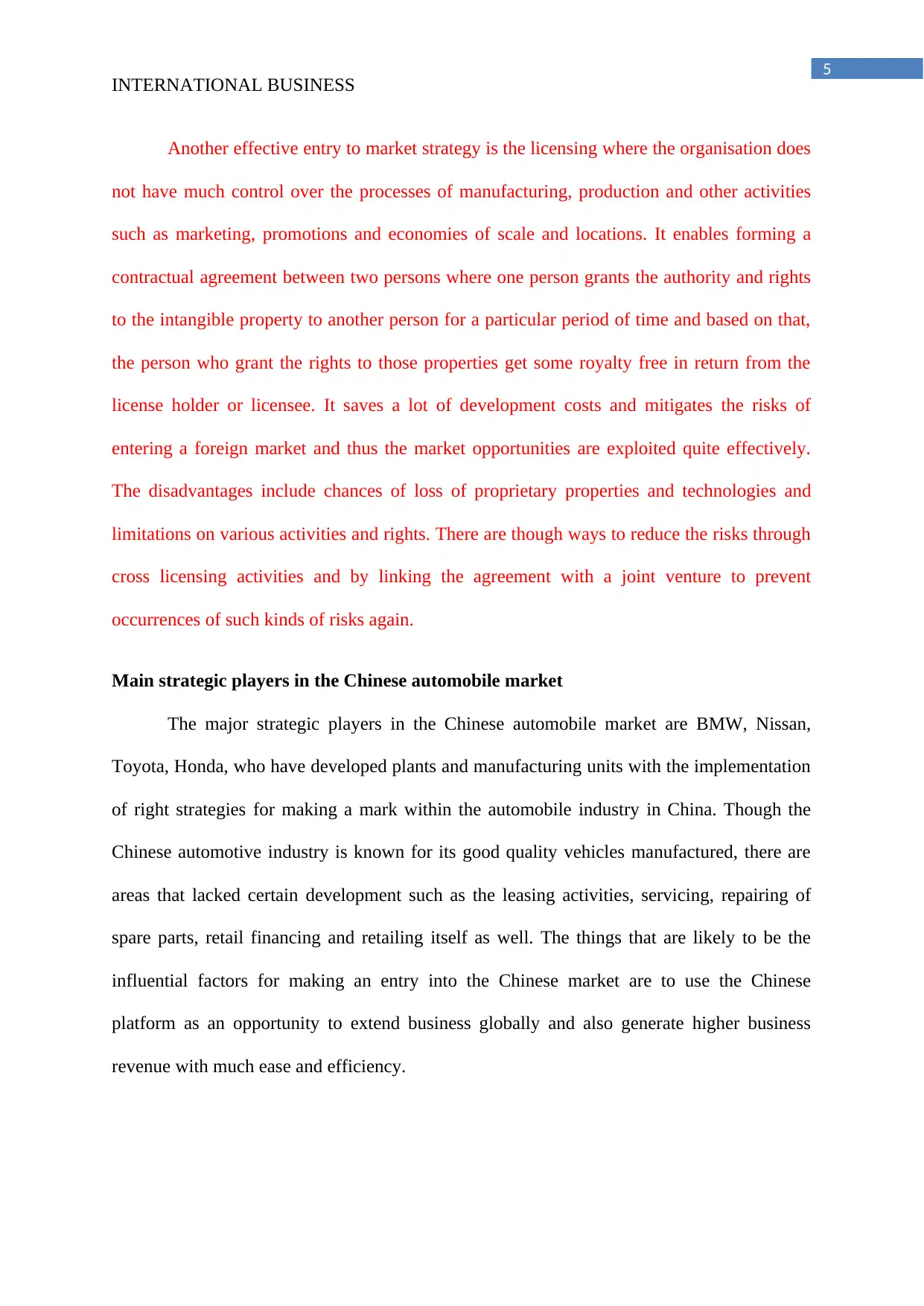
5
INTERNATIONAL BUSINESS
Another effective entry to market strategy is the licensing where the organisation does
not have much control over the processes of manufacturing, production and other activities
such as marketing, promotions and economies of scale and locations. It enables forming a
contractual agreement between two persons where one person grants the authority and rights
to the intangible property to another person for a particular period of time and based on that,
the person who grant the rights to those properties get some royalty free in return from the
license holder or licensee. It saves a lot of development costs and mitigates the risks of
entering a foreign market and thus the market opportunities are exploited quite effectively.
The disadvantages include chances of loss of proprietary properties and technologies and
limitations on various activities and rights. There are though ways to reduce the risks through
cross licensing activities and by linking the agreement with a joint venture to prevent
occurrences of such kinds of risks again.
Main strategic players in the Chinese automobile market
The major strategic players in the Chinese automobile market are BMW, Nissan,
Toyota, Honda, who have developed plants and manufacturing units with the implementation
of right strategies for making a mark within the automobile industry in China. Though the
Chinese automotive industry is known for its good quality vehicles manufactured, there are
areas that lacked certain development such as the leasing activities, servicing, repairing of
spare parts, retail financing and retailing itself as well. The things that are likely to be the
influential factors for making an entry into the Chinese market are to use the Chinese
platform as an opportunity to extend business globally and also generate higher business
revenue with much ease and efficiency.
INTERNATIONAL BUSINESS
Another effective entry to market strategy is the licensing where the organisation does
not have much control over the processes of manufacturing, production and other activities
such as marketing, promotions and economies of scale and locations. It enables forming a
contractual agreement between two persons where one person grants the authority and rights
to the intangible property to another person for a particular period of time and based on that,
the person who grant the rights to those properties get some royalty free in return from the
license holder or licensee. It saves a lot of development costs and mitigates the risks of
entering a foreign market and thus the market opportunities are exploited quite effectively.
The disadvantages include chances of loss of proprietary properties and technologies and
limitations on various activities and rights. There are though ways to reduce the risks through
cross licensing activities and by linking the agreement with a joint venture to prevent
occurrences of such kinds of risks again.
Main strategic players in the Chinese automobile market
The major strategic players in the Chinese automobile market are BMW, Nissan,
Toyota, Honda, who have developed plants and manufacturing units with the implementation
of right strategies for making a mark within the automobile industry in China. Though the
Chinese automotive industry is known for its good quality vehicles manufactured, there are
areas that lacked certain development such as the leasing activities, servicing, repairing of
spare parts, retail financing and retailing itself as well. The things that are likely to be the
influential factors for making an entry into the Chinese market are to use the Chinese
platform as an opportunity to extend business globally and also generate higher business
revenue with much ease and efficiency.
⊘ This is a preview!⊘
Do you want full access?
Subscribe today to unlock all pages.

Trusted by 1+ million students worldwide

6
INTERNATIONAL BUSINESS
INTERNATIONAL BUSINESS
1 out of 7
Related Documents
Your All-in-One AI-Powered Toolkit for Academic Success.
+13062052269
info@desklib.com
Available 24*7 on WhatsApp / Email
![[object Object]](/_next/static/media/star-bottom.7253800d.svg)
Unlock your academic potential
Copyright © 2020–2025 A2Z Services. All Rights Reserved. Developed and managed by ZUCOL.




